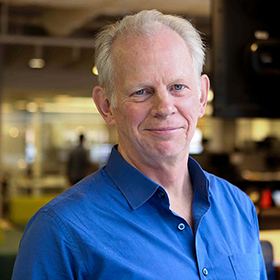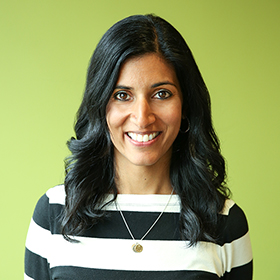In 1960, Rev. Dr. Martin Luther King Jr. published an essay in which he acknowledged the “suffering, frustration, and agonizing moments [that] I have had to undergo occasionally as a result of my involvement in a difficult struggle.” But he also voiced a sense of cautious optimism—a sense that “every crisis has both its dangers and its opportunities.” More than 60 years later, all throughout this past, most tumultuous year, we have seen many nonprofit organizations lean into King’s belief that even in the midst of great darkness, often there are bright opportunities to accomplish more.
Now more than ever, nonprofits face a more volatile and unpredictable environment. However, through The Bridgespan Group’s work (in partnership with Emerson Collective) supporting four dozen nonprofits in Emerson Collective’s portfolio, we have had a close-up view as these leadership teams navigated the pandemic and the ongoing fight for equity and justice, even as they pursued new ways of working; new pathways for evolving their programs; and new strategies for supporting more constituents.
For example, New Door Ventures used the crisis to reshape its entire career-skills curriculum for young people who are out of work or school. In just a few short weeks, ImmSchools raised $200,000 to create a COVID-19 response fund for undocumented families, even though such work previously stood outside of the young nonprofit’s field of focus. The Climate Reality Project also had to make a quick pivot, to re-create the way it trained thousands of climate activists to lead change efforts in their communities.
This article is the third in a three-part series highlighting strategies for strengthening nonprofits so that they are better prepared to push through the current crisis—and the challenges to come. Learn more about the series in the introduction, “How to Build Nonprofit Resilience.”
Despite having to re-invent on the fly during a global pandemic, these organizations not only supported their constituents, but did so in new, sometimes outsized ways. In doing so, these and other nonprofits demonstrated one of the core features of organizational resilience: they reframed the crisis, viewing it as an important moment to imagine, and then invent, better possibilities for the communities they serve—even as they and their communities grappled with spirit-depleting adversity.
More likely than not, any nonprofit that seeks to come out of this crisis (or the next) stronger and more adaptable than it was before will have to work through two conundrums: How do we identify a game-changing opportunity when there is so much uncertainty?
And then, how do we reduce the risks that come with making that opportunity a reality?
Identifying Opportunity: Karam Foundation
Resilient nonprofits “think long and short.” They align around a long-term vision of what their community would look like if it was thriving within the next 10 years. At the same time, they map out where they need to land within the next 18 months if they are to make real progress toward that far-off point on the horizon. Opportunities that nonprofits are interested in—opportunities to unlock momentum toward that 18-month destination—are born out of changes or events that open new pathways to social impact. Those events are likely external, such as a new partnership or funding stream. But they aren’t always obvious, and they rarely take shape in one “Eureka!” moment.
Identifying the kind of opportunity that can propel a nonprofit toward its near-term destination during great crisis requires a willingness to focus on what matters most and to flex as on- the-ground conditions change. That was what Karam Foundation discovered in 2020, when it looked like the pandemic would severely compromise the nonprofit’s core program.
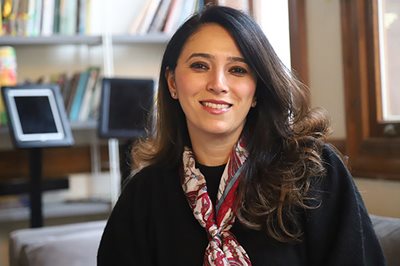
(Photo: Karam Foundation, Courtesy of Karam House)
Karam Foundation came to life around Founder/CEO Lina Sergie Attar’s kitchen table in Chicago in 2007. The original idea was to inspire Chicago’s Arab American community to give to worthy causes (“karam” means “generosity” in Arabic), such as supporting under-resourced communities in the city’s South Side and Iraq War refugees in Boston. For its first few years, the foundation’s business model “was for our bank account to be as close to zero as possible at all times,” Attar recalled. “Whatever we raised, we distributed.”
However, beginning in 2011, Karam put all its focus on Syria, as the country descended into a devastating civil war that has thus far forced more than 6.6 million of its citizens to flee their homeland. While touring a vast, Syrian refugee camp in Turkey, Attar and her volunteer partners—journalists, writers, professors—imagined an alternative to such semi-permanent camps, where so many thousands of families languished for years.
Rather than attempt to serve the many, Karam Foundation would at first focus on far fewer, by investing in the futures of displaced Syrian young people—the next generation, which was in danger of becoming a “lost generation,” said Attar. And rather than address those young refugees’ most basic needs, as big, charitable organizations were already doing, Karam would help them attain a first-class education, built around a STEM-based curriculum that was developed in partnership with NuVu, a Cambridge, Mass.-based innovation school founded by graduates of MIT. It would also create safe, modern spaces for collaborative learning, complete with Wi-Fi and laptops for every student. Attar and her team called these learning spaces “Karam Houses,” locating one such house in Istanbul and the other in Reyhanli, near Turkey’s border with northern Syria.
With the Karam Houses providing an escape from the war’s traumas and workshops that fostered critical thinking and the opportunity for self-discovery, many resettled refugee young people flourished. So much so that Karam Foundation was emboldened to define an outsize, long-term vision for its future: launch enough Karam Houses and other programming to produce 10,000 leaders by 2028—young Syrians equipped with the skills and knowledge to ripple out into the world and pioneer their own pathways for supporting refugee children and their families.
But then came the pandemic. Because they were public spaces, the Karam Houses were suddenly at high risk of hosting a super-spreader event. In the spring of 2020, Karam Foundation very reluctantly shuttered both houses and scrapped its plan to build a third. “We had to throw away our beautiful plan and that was really, really hard,” Attar recalled. One of the biggest hazards the nonprofit had to confront was the risk to its impact: how could Karam Foundation support its young students virtually, when so much of its work “has to do with the place itself”?
One of Karam’s guiding principles for making consequential decisions amid great uncertainty is written into its playbook for building resilience: “Challenge ourselves to find opportunities in the face of obstacles.” Karam set about looking for a game-changing opportunity to accomplish more by redefining its superpower. All resilient nonprofits possess an inner superpower—that “special something” that makes the organization a vital ally for those it serves.
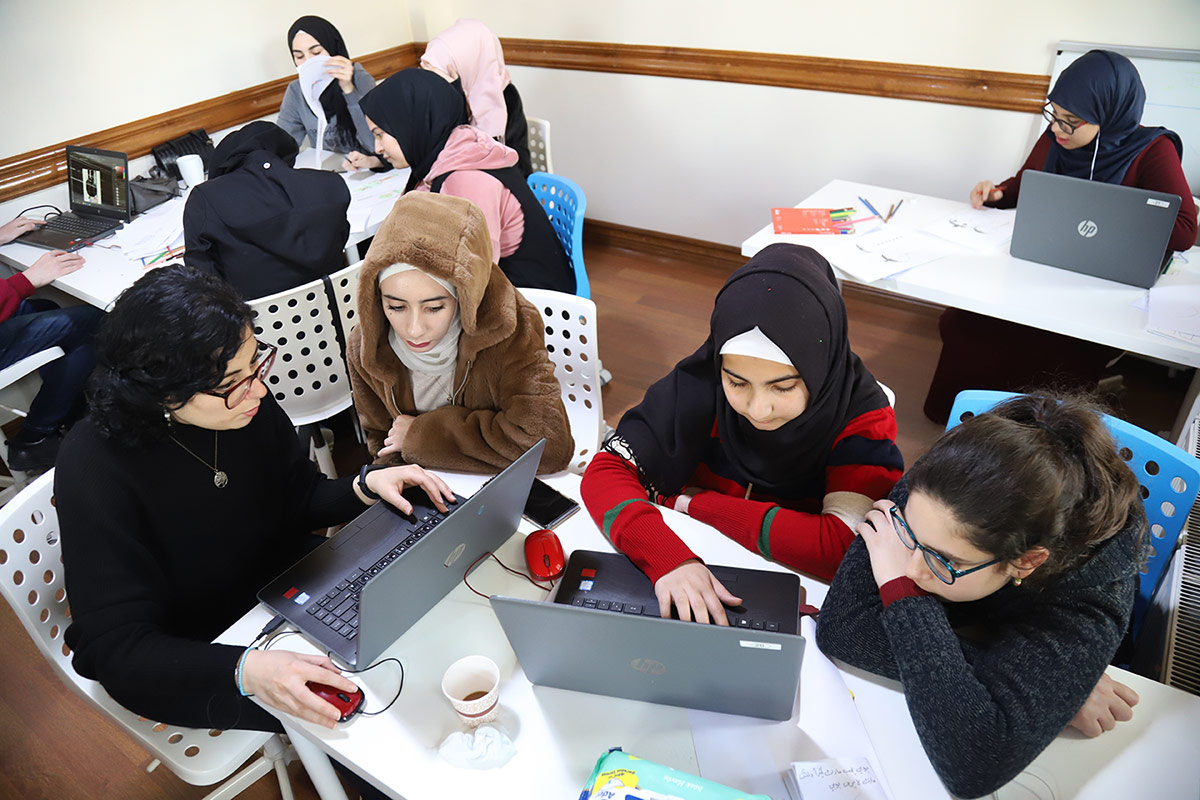 Future Leaders learning the art of storytelling at Karam House. (Photo: Karam Foundation, Courtesy of Karam House)
Future Leaders learning the art of storytelling at Karam House. (Photo: Karam Foundation, Courtesy of Karam House)
At first glance, Karam Foundation’s superpower appeared to be its capacity to create those physical learning environments for war-weary young Syrians. But Karam’s real superpower resided, as it so often does, in something much deeper: Attar and her team’s ability to understand the Syrian refugee experience and respond authentically to refugee needs. That sense of visceral connection is captured in the fact that the Karam Houses were almost entirely run by Syrian refugees, for Syrian refugees.
By tapping into its superpower, Karam Foundation doubled down on continuing to live into its 10-year goal, despite all the obstacles. “We no longer had our space and our kids had nothing at home,” said Attar. “No access to laptops or even access to learning materials.” Nevertheless, the nonprofit re-imagined what it would seek to accomplish in the near term, by paring its strategic plan down to only what mattered most: learning how to teach virtually, while at the same time ensuring that students acquired the tools to learn virtually.
Karam chipped away at the challenge and soon scored a few quick, confidence-building wins. The nonprofit set up bank accounts for refugee families, so it could wire cash stipends to them during a time of great need—reducing the risk of children being forced back into child labor. Staff walked students through the process of setting up Gmail accounts and the Google Hangouts app on their mobile phones, so they could get a break from the pandemic’s isolating effects and socialize with friends. In the ensuing weeks, mentors delivered workshops to students via the Internet and a dedicated team supported Karam’s college students during the shift to remote learning.
As Karam Foundation made some progress toward delivering its programs virtually, it became a little clearer that what appeared to be an insurmountable obstacle might in fact be an opportunity to transform the lives of many more displaced Syrian youth, even after both Karam Houses reopened on a limited basis last fall.
“If this works, our model for scaling completely changes,” said Attar. “We’re no longer limited to operating out of a city or even a country. That’s what our 18-month plan comes down to. By the end of 18 months, we need to know whether we can deliver our programs online while still maintaining the same quality. It’s a big goal, but it’s very focused.”
De-Risking Opportunity: IRAP
Of course, every potential game-changing opportunity comes with varying degrees of uncertainty. And every nonprofit that chases a chance to affect more lives, Karam Foundation included, must likely have to grapple with at least one of three risk scenarios. There’s a financial risk: is there enough of a dedicated funding flow to sustain the effort— and if the results are promising, scale it? There’s an execution risk: does the nonprofit have the capacity to support the work? And there’s a risk to impact: will this new approach actually make a meaningful difference in the lives of constituents?
One nonprofit that has developed approaches for reconciling some of the risks of pursuing an emerging opportunity is the International Refugee Assistance Project (IRAP). At its core, IRAP is powered by a global network of volunteers—2,100 law students in the United States and Canada, and pro bono attorneys from dozens of international law firms and multinational corporations—who since 2010 have delivered free legal aid to 200,000 displaced people from over 70 countries. The organization has also pioneered additional pathways for serving people fleeing war, violence, and political persecution, such as by creating an in-house litigation shop. One result of that effort: IRAP was the named plaintiff in the first lawsuit to challenge former President Trump’s 2017 executive order restricting people from seven majority Muslim countries from entering the United States.
Although IRAP has offices in the United States, Lebanon, Jordan, and Germany, it delivers the majority of its legal services remotely, via email, text, and WhatsApp. As a result, the COVID-19 pandemic failed to crack IRAP’s bedrock: legal-services teams continued to fight for their clients, given their largely digital-delivery model.
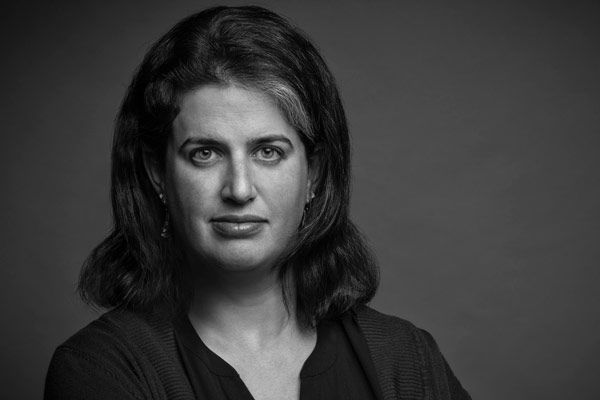 IRAP Director Becca Heller (Photo: IRAP)What about new efforts and ideas that IRAP had planned to explore? As was true for many other organizations, the pandemic brought different and greater levels of risk to many of the expansions and innovations that IRAP had wanted to pursue. However, IRAP’s director, Becca Heller, believes, “If you don’t take risks, you’ll never do anything innovative. So we try to figure out how to take those risks in a hedged way.”
IRAP Director Becca Heller (Photo: IRAP)What about new efforts and ideas that IRAP had planned to explore? As was true for many other organizations, the pandemic brought different and greater levels of risk to many of the expansions and innovations that IRAP had wanted to pursue. However, IRAP’s director, Becca Heller, believes, “If you don’t take risks, you’ll never do anything innovative. So we try to figure out how to take those risks in a hedged way.”
In fact, for IRAP, instituting ways to evaluate and mitigate risk became the determining factor in enabling them to still bring potentially promising ideas to life, even during an unprecedented time. In the past year, the nonprofit has launched efforts to reunify some of the hundreds of thousands of families that have been splintered by wars and other crises, including more than 150,000 unaccompanied refugee children. IRAP has also tested ways to extend its legal-aid work to the chronic refugee crisis at the US-Mexico border. And it has begun to explore legal protocols, which are currently nonexistent, for protecting “environmental migrants” fleeing the calamitous effects of climate change—a displaced population that United Nations forecasters say will number nearly 1 billion people by 2050.
To make all of this possible, here are practices IRAP put in place to hedge the three kinds of risk when facing great uncertainty.
Financial risk: Heller has one simple rule to ensure that IRAP has the financial wherewithal to pursue an emerging opportunity: never implement a pilot project without first lining up at least two years of funding for it. By locking in a longer term, upfront funding flow for its new work, IRAP buys itself some protection against missteps that might sink a core program.
“We have a policy that we won’t hire a staff person unless we can ensure it’s a permanent job, so naturally we have to make sure we have funding for them on new projects,” she said. “But also, you don’t want to chase that shiny new thing at the expense of your existing programming.”
Execution risk: IRAP expects that with new initiatives, it won’t get everything right the first time or for that matter, the tenth time. To protect against a scenario where the inevitable setbacks overwhelm a team or tax other parts of the organization, IRAP starts small, with learn-as-you-go pilot projects. For example, it began its legal-aid initiative at the US-Mexico border with just 30 cases, to better understand the hurdles that must be overcome and to gauge the potential for growth.
IRAP will also form partnerships on new initiatives, to fill skills gaps and areas of expertise. For example, IRAP is working with the Natural Resources Defense Council on its climate displacement project. It also launched its family reunification program in partnership with the UN High Commissioner for Refugees (UNHCR) and RefugePoint, an NGO that serves at-risk refugees. By striking these alliances, IRAP distributes some of the nontrivial amount of bandwidth and effort that goes into launching, monitoring, and evaluating pilot projects.
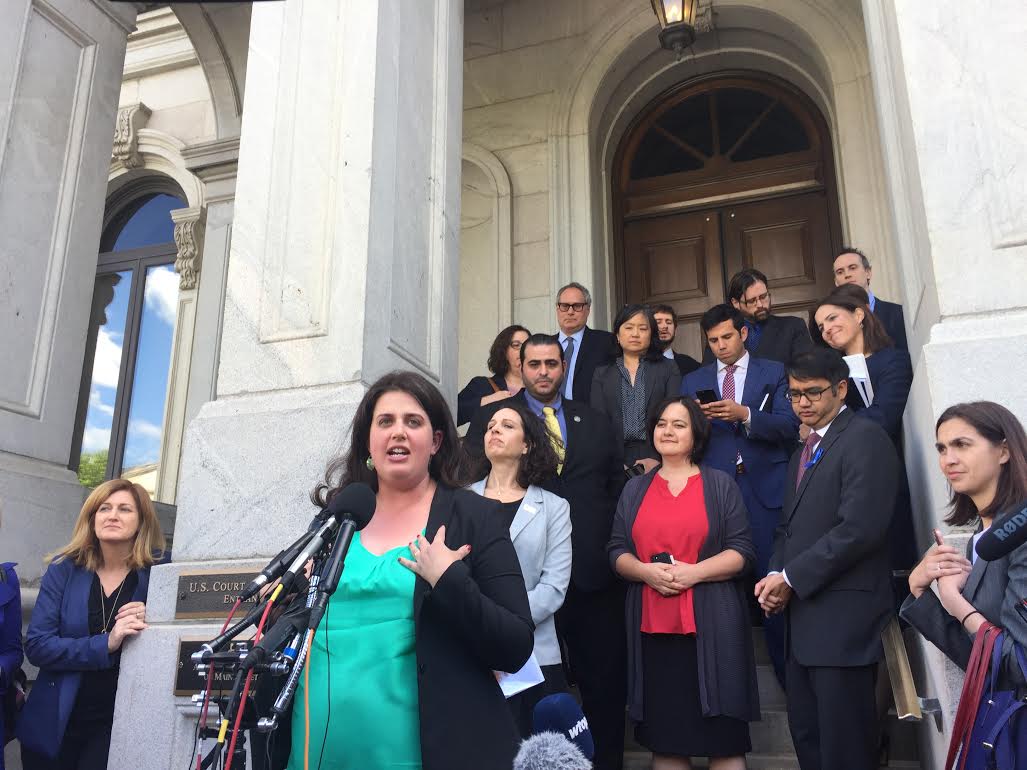 IRAP Director Becca Heller speaking after oral arguments in IRAP v. Trump, the first lawsuit to challenge the 2017 Muslim ban. (Photo: IRAP)
IRAP Director Becca Heller speaking after oral arguments in IRAP v. Trump, the first lawsuit to challenge the 2017 Muslim ban. (Photo: IRAP)
Moreover, piloting a promising idea gives organizations the space to test, make mistakes, and learn and improve rapidly. More than 3 million people throughout the world qualify for family reunification, but even with two robust partners, IRAP again started small, with 125 cases in six different countries. “I think that’s a responsible way to grow a new program,” said Heller. “We’re not going to get it totally right. So when we get something wrong let’s be open-minded about it, think critically, and address it as we iterate.”
This “learn before you earn” mindset helped IRAP pivot from a project that made a lot of sense at the outset, until it revealed a pathway that could potentially propel the organization toward far greater impact.
IRAP launched a pilot to create a searchable database that would track all the various pathways to immigration in various destination countries, such as work visas, education visas, and family reunification provisions. The idea would be for frontline NGOs to use the database to find a pathway for someone who is stuck in one country (say, Afghanistan) to immigrate to another (Switzerland). “Eight months into the project, we realized that family reunification availability exponentially dwarfed every other pathway,” said Heller.
“Reuniting a mom with her kids is pretty much the most nonpartisan, compelling argument you can make [for refugees and asylum seekers],” she continued. “Plus, family reunification is a right in most places and there’s an incredible need for it. But no one has ever tried to create a global, family reunification legal aid team. So we threw out the database and started this pilot with UNHCR.” After commencing with that pilot consisting of 125 cases, by the end of 2020, IRAP’s legal team provided direct reunification services to nearly 900 individuals separated from family members.
IRAP’s shift from the database project to something much bigger underlined an unexpected lesson for would-be innovators seeking to advance their impact during a crisis: pursuing an opportunity almost always comes with an element of risk, but reckoning with risk can sometimes reveal even more of an outsize opportunity.
Some Takeaways
Even in difficult times, nonprofits can still play offense. Sometimes, a crisis can be so paralyzing that it seems almost impossible to map out the best course of action to take. That in fact, there is so much stasis that people decide subconsciously to avoid making any kind of consequential decision at all. That could have been the case for Karam Foundation, when the pandemic forced it to suspend its core program. But instead of hunkering down, the nonprofit stayed positive and looked for low-risk ways to go on offense.
Want to put the advice from this article into practice? Download the "Conversation Starter: How to Identify Risk While Seizing Opportunity" to get started. Download the conversation starter >>
Nonprofit leaders who play offense during a crisis work to develop near-term actions that can still help the organization make progress toward its destination. One way to begin that process is by asking this question: what can we do today, based on where we want to go and where we feel most confident? If there are few or no downsides to the work and the line of pursuit is straightforward, it might well be an opportune moment to act.
More options, and perhaps more opportunities. When organizations like IRAP always have an array of pilot projects in play, they underline the fact that to improve their chances of moving closer to their long-term destinations, nonprofits would be wise to generate a compelling array of new strategic options—exciting alternatives to the status quo. Such organizations generate perhaps a dozen ideas every year, knowing that maybe six will be worth experimenting with and out of those, perhaps a couple will merit a significant investment and one might reveal a powerful way to affect many more lives.
This addition-by-subtraction approach, where nonprofits continually work to build a healthy portfolio of strategic options, helps them better adapt to whatever might come next—a key feature of organizational resilience.
Opportunities aren’t always “out there.” Even though it’s important to have a search strategy for identifying emerging opportunities and testing them to see if they are really real, it doesn’t always mean that high-potential ideas are to be found only out on the fringe of the organization’s experience. Sometimes, they reside right within the organization’s core work. The trick is to be alert enough to spot them, even when people are working way down in the weeds.
“So much of our policy asks and opportunities for different litigation services arise out of our direct client work,” said Heller. “Stuff that we wouldn’t know needed to be litigated, or we wouldn’t know needed a policy fix, but for the fact that we’re doing thousands of these cases every year.”
Three Final Thoughts
First: If your team wants to work through options for responding to risks while pursuing an emerging opportunity to advance toward your long-term goals, this brief primer for starting that conversation can help.
Second: Over the course of this series on building nonprofit resilience, we have described how organizations move through three phases as they lean into adversity. First there is contemplation, where nonprofits “think long and short” to define their 10-year vision and map out the first, near-term steps they will take to achieve it. Then there is preparation, where they identify and tap into their superpower—the unique assets that will propel them toward their goal. Finally there is action, where they hedge the risks and seize the opportunity for impact.
Based on what Bridgespan has observed, working through these three phases increases the odds that nonprofits will make themselves a bit more fit for the future’s challenges.
And finally: As the American Psychological Association has noted, traumatic events often lead people—and we would argue, sometimes even organizations—to isolate themselves, which so often drains their confidence and resolve. But just as it makes sense for individuals to prioritize relationships during periods of great adversity, organizations can prioritize partnerships.
Whether it’s hundreds of philanthropies across the United States coming together to launch COVID-19 emergency relief funds or individual nonprofits like IRAP striking alliances with other actors to pilot promising ideas, there is power in human-to-human, organization-to-organization connection. And there is power in recognizing that even in the midst of globe-spanning trauma, we are all in it together.
As Karam Foundation’s Lina Sergie Attar put it: “Your privilege and your financial status is not going to save you, not when so much is broken. That’s the biggest lesson of the pandemic: we can’t be fully well until everybody is well.”
Meera Chary, a partner in Bridgespan’s San Francisco office, co-leads (with Bridgespan Partner Preeta Nayak and Bridgespan Principal Colleen Brosman) the Nonprofit Resiliency Initiative, in collaboration with Emerson Collective. Bridgespan Editorial Director Bill Breen is based in Boston.

